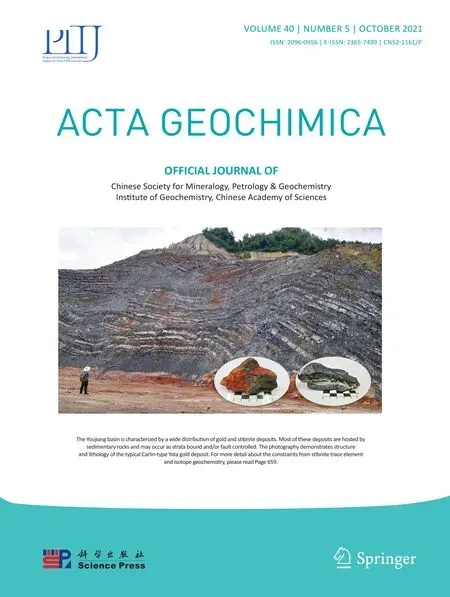The possible source of uranium mineralization in felsic volcanic rocks,Eastern Desert,Egypt of the Arabian-Nubian Shield:Constraints from whole-rock geochemistry and spectrometric prospection
Gehad.M.Saleh·Bahaa.M.Emad·Ibrahim.B.Abdel Kader·Rania.M.Sakr
Abstract The present work deals with the detailed geology, mineralogy, geochemistry, and spectrometric prospection of the felsic volcanic rocks at the Eastern Desert,Egypt of the Arabian-Nubian Shield.Felsic volcanic rocks are an essential source for rare earth elements(REEs)and uranium occurrences in this area.They are compositionally uniform with tholeiitic to calc-alkaline aff inities,peraluminous and belong to the series of rhyolite with high-K melt.They exhibit more enrichment in high f ield strength elements(HFSE,e.g.Zr,Ta,Nd,Th,and U)and large-ion lithophile elements(LILE,e.g.Pb and Rb)compared to the country rocks of the studied area,with REE ranging from 188.20 to 442.70 ppm and strong depletion in Ti,Sr,Pwith deep negative Eu oddities.The felsic volcanic rocks were mostly generated from the partial melting of quartz-amphibolite facies accreted during the Neoproterozoic.Positive oddities of Zr-U-Th for the felsic volcanic rocks determine the involvement of crustal materials.Felsic volcanic rocks are found in A-type suites of magma and represent highly fractionated rocks derived from rhyolitic magma,with insignif icant interaction with continental crust in the low-pressure environment and during fractional crystallization.Felsic volcanic rocks have higher values of radioactivity in which eU range from 0.5 to 121 ppm and eTh from 1.0 to 415.10 ppm.The high values of eU and eTh can be ascribed to the mineralization of uranium and the presence of accessory minerals of radiogenic naturesuch asuranophane,uranothorite,zircon,and monazite.Uranophane is considered as the mineral with most enriched uranium contents in the studied felsic volcanic rocks in which(UO2=87.30 wt%).Also,they are enriched with REE-bearing accessory minerals comprising allanite,titanite,and apatite.The geological investigations of the felsic volcanic rocks in the studied areas are inappropriate to clear the feasible economic potentialities of rare earth elements and U occurrences;itemized and invaluable explorational work is as yet needed.Whilst,the environmental impact of mineralization,owing to U and Th and their radiogenic daughter products,is observed and must be elaborated minutely.
Keywords Felsic volcanic rocks·Geochemistry·REE·Uranium mineralization·Egypt·Arabian-Nubian Shield
1 Introduction
The source of uranium is exemplified by plutonic rocks,either L-type peraluminous leucogranite or high-K calcalkaline granites or equivalent volcanic rocks,for many hydrothermal deposits(Cuney 2014).Peralkaline plutonic rocks do not represent a signif icant U source,but peralkaline volcanic rocks and especially peralkaline tuffs are the main U source for a variety of volcanic uranium deposits.Hydrothermal volcanic uranium deposits are mostly related to peralkaline volcanic rocks(Cuney 2014).The world’s largest uranium district of this type(280,000 t U at 0.2%)is the late Jurassic Stretsovkoye caldera in Transbaikalia,Russia(Chabiron et al.2003).Hydrothermal circulations occurred during the waning stages of magmatic activity within a large caldera.Drilling to a depth of 2700 m through the Streltsovka caldera and basement provided a unique opportunity to evaluate the role of the different source rocks which may be involved in the genesisof thedeposits.Three sourcesmay have contributed to the formation of the uranium deposits in the Streltsovka caldera:(1)the peralkaline rhyolites f illing the caldera,(2)the f luids expelled from the volcanic melts or the underlying magma chamber,and(3)the subalkaline rocks of the basement.Among the volcanics,the rhyolites alone may have yielded more uranium reserves estimated for the Strelstovska caldera(Chabiron et al.2003).High-K calcalkaline metaluminous volcanic rocks are generally a less favorable U source because a signif icant but variable portion of the U in theserockstendsto betrapped in accessory minerals(Leroy and George-Aniel 1992).Most deposits related to this type of volcanism have a relatively small size.Highly peraluminous acidic volcanics,mineralized in U are essentially known in the Macusani district,Peru.Pitchblende and autunite occur in sub-vertical to sub-horizontal fractures in the top tens of meters of Pliocene crystal-rich f lows/tuffs.A resource of 30,000 t U has been estimated for the whole Macusani district at an average grade of 0.1%U(IAEA 2009).
By contrast with peralkaline plutonic rocks,Peralkaline felsic volcanic rocks(e.g.liparites)clarify an important uranium source,because most of the uranium is in the glassy matrix(Cuney 2014).When the glass becomes devitrified during alteration,the uranium can easily be mobilized.These units form extensive and thick layers of pyroclastic tuffs(ignimbrites)within and outside volcanic calderas.The Latium Province in Italy,an area covering more than 2000 km2,represents one of the most recent examples of such a pyroclastic tuff sheet strongly enriched in U(Villemant and Palacin 1987).High-K calc-alkaline volcanic rocks may represent a signif icant uranium source if the magmas are fractionated and if the U is dominantly hosted by the glassy matrix rather than in U-bearing accessory minerals(Cuney 2014).
Felsic volcanic rocks around the world have not received due attention in the exploration for uranium(Maithaniand Srinivasan 2011),but in fact,felsic volcanic rocks have been investigated by many studies(e.g.,Cunningham 1998;Chabiron et al.2001,2003;Nash 2010;Aslan 2017;Dailey et al.2018;Saatci 2018;Bonnettiet al.2020a,b).The uranium resources contributed by volcanic uranium deposits all over the world stand at 3,62,000 t U3O8(IAEA 2009).Among the acid volcanics,rhyolites form an ideal sourcefollowed by welded tuffs,ignimbrites,etc.(Maithani and Srinivasan 2011).The alkali type rhyolite or topaz rhyolite is ideal for its enrichment in many lithophile elements including uranium,which are amenable to subsequent leaching by meteoric water.Uranium may also be extracted by solution activity from the volcanic glass shards(Walton et al.1976).Streltslovka’s felsic volcanic rocks(especially the phase of glassy rhyolitic)are considered the most suitable source for uranium and molybdenum(IAEA 2009;Chabiron et al.2003;Mikula´sˇ2015).Felsic volcanic rocks of altered type are a possible exploration aim for REE resources of ion adsorption type(Deng 2013;Wang et al.2013;Yang et al.2015;Zhao et al.2017;Szemere´di et al.2020).The REE deposits of ion adsorption-type associated with felsic volcanic rocks account for 37.87%of the total of such type deposits in South China,and these ores are of decent value with a high proportion of iREEs(>65%)(Zhang 1990).
The acidic volcanics play an important role as a potential provenance for uranium mineralization as a detailed work performed in Australia(Maithani and Srinivasan 2011)and South China(Bonnetti et al.2020a).Volcanic rocks,especially the felsic varieties are often found to be richer in uranium and thorium than their plutonic equivalents,with earlier eruptions showing the highest concentrations(Maithani and Srinivasan 2011).Uranium in volcanic rocks is bound in the matrix making them easily separable,which is a prerequisite in the volcanic uranium ore-forming process(Maithani and Srinivasan 2011).The felsic volcanic rocks,such as rhyolite,rhyodacite,and dacite have uranium contents higher than the crustal age,due to magmatic segregation(Maithaniand Srinivasan 2011).Klepper and Wyand(1956)quote a study revealing that volcanic rocks are often 1.5-times higher in uranium content than their intrusive equivalents.In the felsic volcanic rocks,uranium occurs as a uraniferous accessory mineral(e.g.zircon,sphene,apatite),in the secondary oxide of iron-manganese(or)titanium in volcanic glass and at mineral grain boundaries,crystal defects and cleavages(Zielinsky 1981).
It has been recognized that felsic igneous rocks contain higher uranium concentrations than other rocks.The common spatial association of graniteand rhyolitesuggests that such rocks are potential sources of uranium(Cuney 2003).It’s known that granites are one of the most favorable host rocks for U-mineralization in the world,especially those of peraluminous two-mica granites(Cuney et al.1984;Poty et al.1986;Friedrich et al.1989;Bonnetti et al.2018a,b;Yu et al.2020).The most important prospecting areas for U-mineralization within the plutons at the Eastern Desert such as El-Erediya(El Kassas 1974),El Missikat(Bakhit 1978),Gattar(Salman et al.1990),El Sela area(Ibrahim 2005;Zeid 2020),Abu Rusheid area(Saleh 1997;Ibrahim et al.2015)and G.Um Ara(El-Naby 2009).Uranium existing in granites can be genetically divided into two types;primary uranium and secondary uranium(Jiashu and Zehong 1982).In Egypt,extensive programs were conducted for uranium exploration in the Eastern Desert granites,while the acid volcanics still need more activity to evaluate them as uranium potential sources.Radioactive mineralization of uranophane,uranothorite,and enrichment with rare earth elements were recorded asfracture-f illingsin thesheared partsof thefelsiterocksat Um Saf iof the Arabian-Nubian Shield(El Ghawaby 1966;Ibrahim 2001).
Few studies were carried out on the so-called felsic volcanic rocks in the Eastern Desert(ED)of the Arabian-Nubian Shield(eg.Essawy 1972;Essawy and Abu Zeid 1972;El-Kassas and Bakhit,1989;Abu El-Ela 2001;Ali et al.2009;Gharib and Ahmed 2012;Zoheir et al.2020).So,this work displays new geological,geochemical characteristics and spectrometric prospection on the Wadi Ranga,Wadi El Miyah,Wadi Shait,and G.Atalla volcanics of the Arabian-Nubian Shield to articulate the classif ication of these rocks,their tectonic setting,magma types,radioactivity,and petrogenetic relationships between the different felsic volcanic rocks.
2 Geologic setting
2.1 Regional geology
The basement rocks of the Eastern Desert of Egypt are a part of the Arabian-Nubian Shield.The Arabian-Nubian Shield represents an excellent example of the Pan-African orogenic cycle that haslong been recognized asa period of major crustal accretion(Kro¨ner 1984).It is dominated by a juvenile crust that formed during the Neoproterozoic time(850-600 Ma)by growth and accretion of intra-oceanic arcs and/or oceanic plateaus(Abdelsalam et al.2003)before the collision between East and West Gondwana(Abdelsalam et al.2003;Stern 1994).Neoproterozoic volcanic rocks found in the Egyptian Eastern Desert(ED)basement rocks of the Arabian-Nubian Shield can be assorted into four main volcanic episodes as follows,a,ophiolitic metavolcanics,b,island arc metavolcanics,c,Dokhan volcanics,and d,alkalinevolcanics.Thefelsitesof the Post-Hammamat sediments include felsite porphyry and quartz-porphyry bodies,effusive felsite,sheets,plugs,and breccias which are associated with the Hammamat Molasse type-sediments in several localities in the Nubian Shield(Akaad 1957;Essawy and Abu Zeid 1972).The f ield relationshipsbetween the felsitesand both the Dokhan volcanics and Hammamat sediments are best developed at the W.Queh area,where the Dokhan volcanics are separated into lower and upper sequences by a thick succession of Hammamat clastic sediment and the felsite bodies intruded both of them.
Felsic volcanic rocks(<580 Ma)occur as small outcrops among the Pan-African basement complex of Egypt of the Arabian-Nubian Shield and commonly are referred to as Post-Hammamat felsites since they have intrusive relations with these molasses sediments(Hassan and Hashad 1990;Abdeen et al.1991;Dessouky et al.2018).According to Greenberg(1981),the felsites could be related or comagmatic to the plutonism of the younger granites of the Arabian-Nubian Shield.Abdalla(2001)reported that;both the distinctive REE-F enriched signature for Um Saf ifelsite of the Arabian-Nubian Shield and Nb-F for the coeval and geochemically similar specialized granitoids can be attributed to the various degree of protracted fractionation and depth of emplacement rather than to derivation from different sources.
2.2 Geology of the study area
2.2.1 Wadi Ranga felsites
The felsite at Wadi Ranga of the Arabian-Nubian Shield form an elongated outcrop along the margin of the basement complex,about 8 km long in an NW-SE direction and whose width variesbetween 500 and 2000 m(Fig.1a).The oldest rocks are a series of metavolcanics including meta-andesitesand metamorphosed volcanic agglomerates,corresponding to the Shadliseries.These metavolcanicsare unconformably overlain by the Igla formation,which dips(Hammamat sediments)of the basement complex at 25°to 45°NE.The volcanic rocks appear to form a thin discontinuous band layering between the Igla formation and the metavolcanics.Felsitic dykes also cut the Hammamat sediments in the central and southern parts of the outcrop.Also,a minor body of felsite is intruded along the underlying metavolcanics(Fig.2a).
2.2.2 Wadi El-Miyah felsites
Thefelsitesare situated at thenorth and thenortheastern of the junction of Wadi El-Miyah and W.Siwiqat Umm Lassaf(Fig.1b).W.El-Miyah felsites of the Arabian-Nubian Shield occur as two minor eruptions about 1500-2000 m long by 800-1000 m wide in the form of plug-like bodies injected along fracture planes trending NE-SW.The rocks are emplaced within the unmetamorphosed red beds of the Igla Formation and mainly consist of felsite and minor felsitic intrusion breccias.W.El-Miyah felsites are affected by alteration processes as,greisenization and then locally followed by f luoritization due to the abrupt emergence of F-rich f luids.Fluoritization is manifested by the development of f luorite-rich felsite zone,f luorite breccias,and veinlets(Fig.2b).
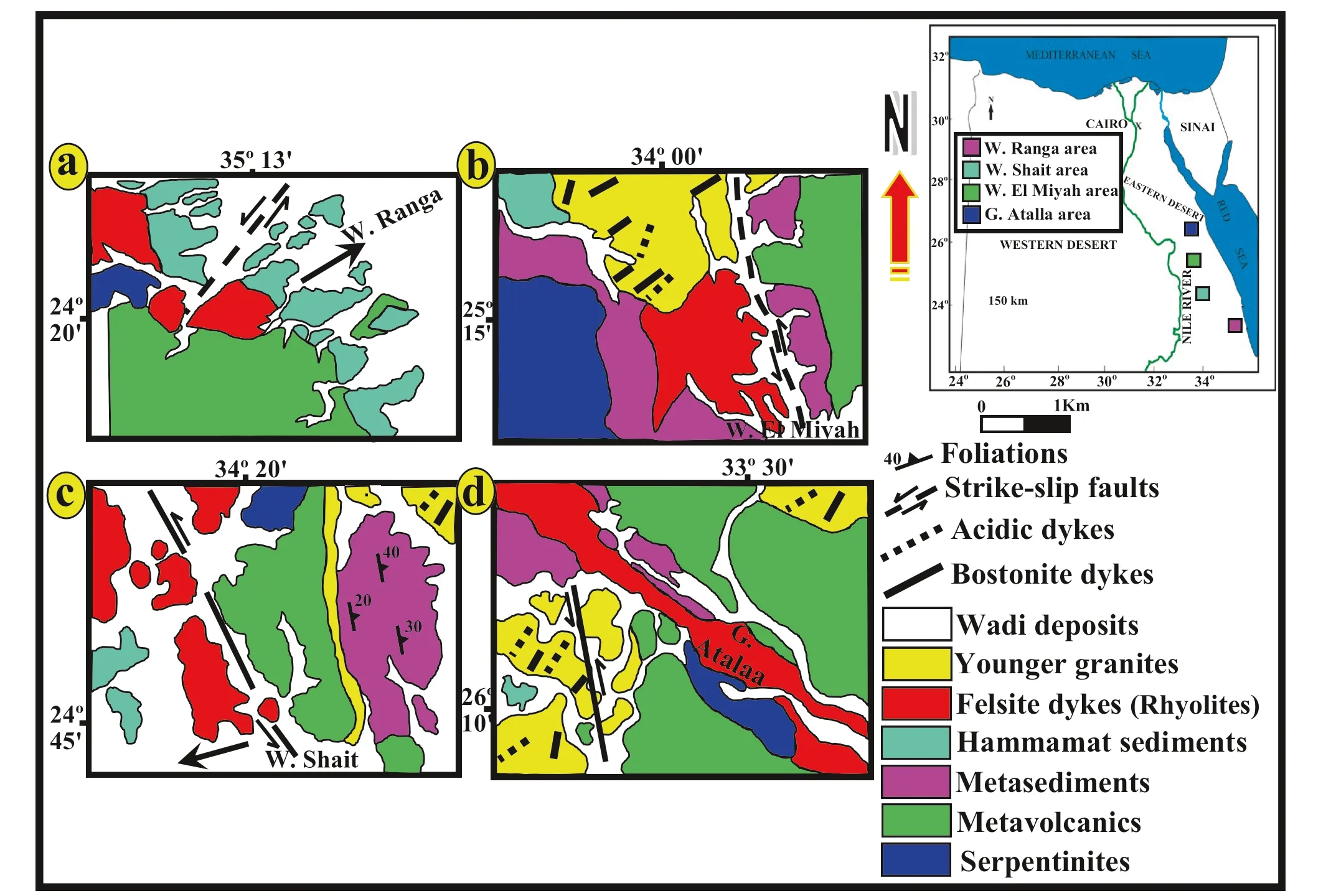
Fig.1 Location and geologic maps of the felsic volcanic rocks a Wadi Ranga,b Wadi El Miyah,c Wadi Shait and d G.Atalla from Eastern Desert(ED)of Egypt of the Arabian-Nubian Shield(mapping by G.M.Saleh)
2.2.3 Wadi Shait felsites
The felsites at Wadi Shait of the Arabian-Nubian Shield lie on the northern side of W.Shait at a point east of Longitude 34°20′00′′E and north of Latitude 24°45′00′′N.They are situated 6 km to the north of the conspicuous trachyte volcanic plug forming G.Hamret Salma(Akaad and El Ramly 1958).The outcrops are in the form of two strips elongated in the N-S direction(Fig.1c).The northern outcrop of the formation is a basal conglomerate and almost consists of pebbles of the underlying purple porphyritesand quartz-porphyriesin a deep brick-red to purple matrix of the volcanic material itself and Hammamat sediments.The southern outcrop of the Igla formation mainly consists of the same basal conglomerate as above.They are cut by a thin dyke of amygdaloidal diabase with porphyritic plagioclase dipping 70°SE.Silicif ication is expressed by the development of many quartz pods(0.4-6 m thick),veins,and veinlets(5-150 cm thick),and cutting the felsite bodies at their apical parts.Some quartz veins contain smoky to black quartz and are closely associated with the radioactive zones(Fig.2c).
2.2.4 Atalla felsites
The Atalla felsites of the Arabian-Nubian Shield intrusion form an elongated sheet-like body about 15-20 km long by 2.5-3.0 km wide.It was forcefully pierced along a thrust plane trending NNW-SSE,and constitutes,by far,the largest felsic intrusion in the basement rocks of the Eastern Desert of Egypt(Fig.1d).According to Akaad(1957)and Akaad and El Ramly(1958),the Atalla felsic intrusion is bounded from its eastern side by basic metavolcanics and metasedimentsand western side by rhyolitic f lowsand tuffs(Fig.2d).The Atalla felsic intrusion is intruded by the younger granitoids and no relations were observed in the f ield between the felsites and the Hammamat sediments.Atalla felsites are f ine-grained,leucocratic massive,and show colors varying from light grey to buff.Most of these felsites dissect the rocks of the Hammamat Group and are,therefore,referred to as Post-Hammamat felsites.
3 Methods and techniques
Fieldwork wasaccomplished by gathering morethan fortyf ive samples from the felsite volcanic of the different studied areas of the Arabian-Nubian Shield.To identify the principal rock-forming minerals and their textures,f ifteen thin sections were prepared for the felsites.For mineralogical investigations,the mineralized samples were f irst disaggregated by crushing and ground,then by using bromoform(sp.Gr.2.8)the light and heavy fractions were segregated,then washed and dried.The resulting heavy mineral fractions were investigated under a binocular microscope.The separated mineral grains were examined by Environmental Scanning Electron Microscope(ESEM)Phillips EXL 130 at the laboratory of the Nuclear Materials Authority of Egypt.To determine the major trace and rare earth elements,eighteen samples from felsites were selected.By using X-ray Fluorescent Spectroscopy(XRF),major oxides and trace elements were analyzed,while rare earth elements were analyzed by using(Inductively Coupled Plasma-Mass Spectrometry,ICP-MS)at Laboratories of Department of Earth Resources Engineering,Kyushu University,Japan,ACME Analytical Laboratories,Vancouver,Canada,and Nuclear Materials Authority,Egypt.Field ground gamma-ray spectrometry survey has been done by using a well-calibrated and high-sensitivity model RS-230 spectrometer.The instrument is manufactured by radiation solution Inc in Ontario City,Canada.The spectrometer is well-calibrated on artif icial concrete pads containing known concentrations of K,U,and Th before the f ield survey.The reference of radioactive source used in RS-230 is137Cs set up with the sensor of the instrument.Thedevicecontainsinternal datastorage,PCdataretrieval,and a GPS unit.The counting time of 120 s is well adjusted.This instrument is used to detect dose rate(D.R.)in unit[nano sievertsper hour(nSvh-1)],potassium(K%),equivalent uranium content(eU ppm),and equivalent thorium content(eTh ppm)on rock outcrops.
4 Results
4.1 Petrology of felsic volcanic rocks
The investigated felsic volcanic rocks belong to the rhyolite series mainly composed of quartz,k-feldspars,and sodic plagioclase(albite and oligoclase).Biotite,muscovite,and opaques occur in subordinate amounts.Rhyolites are f ine-grained with sericite-muscovite assemblage and characterized by microholocrystalline or felsitic texture,rarely relict perlitic,spherulitic,or granophyric.Quartz occurs as subhedral to anhedral crystals and these crystals are elongated and strained to show moderate undulose extinction.Potash feldspars are found as perthite crystals associated with quartz(Fig.3a).Some of the potash feldspar grains are altered into clay minerals and stained with iron oxides(Fig.3b).Generally,plagioclase crystals are commonly deformed showing dislocation(Fig.3c)and characterized by zoning associated with elongated quartz(Fig.3d).Biotite occurs as pale brown to dark brown elongated f lake associated with quartz(Fig.3e)and altered into chlorite(argillitized,sericitized,or carbonatized).Fluorite,garnet,zircon,monazite,xenotime,apatite,and rutile are the common accessory constituents(Fig.3f)and the secondary minerals are sericite,chlorite,and calcite.Chlorite is secondary after amphibole which is present in minor content.Hematite and ilmenite are also present and occur as opaques minerals.
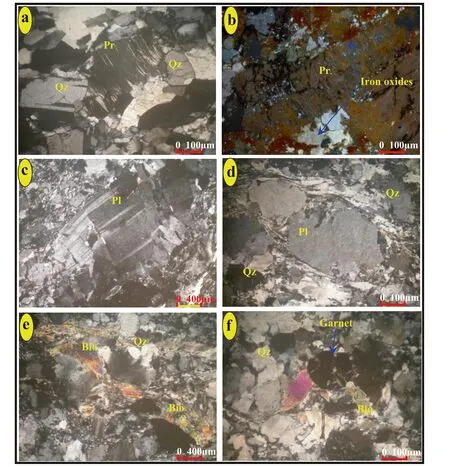
Fig.3 Photomicrographs of the felsic volcanic rocks of studied areas,ED,Egypt of the Arabian-Nubian Shield,clarifying:a Crystal of perthite(Pr)associated with quartz(Qz),b Alteration of potash feldspars to clay minerals and staining of the rock with hematite(iron oxides),c Deformed crystal of plagioclase(Pl)showing dislocation,d Crystal of plagioclase(Pl)showing zoning associated with elongated quartz(Qz),e Elongated f lakesof biotite(Bio)associated with quartz(Qz)and f Crystal of garnet associated with quartz(Qz)and biotite(Bio).All photosare in crossed Nichols
4.2 Mineralogy
The mineralization of the felsic volcanic rocks at different studied areas of the Arabian-Nubian Shield can be assorted on basis of the mode of their occurrence and lithological associations into the following types.
4.2.1 Uranophane[Ca(UO2)(SiO3OH)2(H2O)5]
Uranophane is an alteration product of gummite or uraninite and the chief constitute of the outer silicate zone of uraninitealteration(Nininger 1954).Uranophanegrainsare very soft with different grades of yellow,yellow-orange,and light yellow with a yellowish-white streak.The ESEMEDX pattern of the uranophane(Fig.4a)showed that the UO2(87.30 wt%)and CaO2(5.74 wt%)are the dominant components.
4.2.2 Uranothorite[(Th,U,Ce)SiO4]
Uranothorite is characterized by dark brown to palebrownish in color and commonly anhedral and metamict.According to Heinrich(1962),uranium content is usually present in amounts up to about 10%in this mineral.Uranothorite does not revert its original crystal structure but yields a cubic powder pattern that is identical to that of thorianite(Th>U)O2(Phair and Shimamoto 1952).The decomposition of thorite takes place in an oxidizing environment and in acidic hydrothermal solutions,where U replaces Th producing uranothorite.This concept supports the idea that the area was affected by hypogene solutions rich in U and Th.The ESEM-EDX pattern of the uranothorite(Fig.4b)revealed that the ThO2(44.59 wt%),UO2(16.71 wt%),and SiO2(20.40 wt%).
4.2.3 Zircon(ZrSiO4)
Zircon is tetragonal,most commonly as tabular to prismatic crystals.It isabrittle mineral,with ahardnessof 7.5.Zussman et al.(1966)and Speer(1982)deduced that,when zircon is enclosed by biotite or other colored silicates,it sometimesgivesriseto pleochroic haloesdueto itsamount of radioactive minerals.Zircon grains separated from the felsic volcanic rocks are distinguished by prismatic and bipyramidal crystals and have varying shades of honey color owing to the effect of radioactivity.The ESEM-EDX pattern of the zircon(Fig.4c)exposed that the ZrO2(62.91wt%),SiO2(19.63 wt%),and CaO2(9.85 wt%).
4.2.4 Monazite(Ce,La,Nd,Th)(PO4.SiO4)
Monazite is a rare-earth phosphate with a signif icant substitution of silicon for phosphorous and thorium for rareearth(Heinrich,1962).It can be deemed as LREEs-bearing minerals,especially Ce.Monazite grains derived from felsic volcanic rocksareyellowish-brown to reddish-brown minerals with a resinous to vitreous luster.Jensen(1967)concluded that monazite structure would accept REE ions with ionic radii between those of La and Eu.The ESEMEDX pattern of the monazite(Fig.4d)detected that the CeO2(31.58 wt%),P2O5(21.40 wt%),and La2O3(16.55wt%).
4.2.5 Pyrite(FeS2)
The most abundant and widespread sulphide is pyrite.It is cubic crystals,opaque with greenish-black to brownishblack streak in color.It isbrittle with hardnessranges from 6 to 6.5.The occurrences of sulphide minerals induce reducing conditions favorable for precipitation of radioactive mineralization.During the oxidation of pyrite,oxygen is consumed,resulting in a reducing environment at the zoneof thereaction.The ESEM analysisof pyrite(Fig.4e)shows that pyrite consists essentially of SO3(48.25 wt%)and Fe2O3(51.75 wt%).
4.2.6 Ilmenite(FeO.TiO2)
Ilmenite is the most common Fe-Ti oxide mineral occurring in adiverserange of igneousrocks,somemetamorphic rocks,and detrital mineral grains.Ilmenite could help to f ix the uranium oxide from their uranyl solutions as magnetite(Speer et al.1981).Ilmenite grains separated from the felsic volcanic rocks are distinguished by rounded to subrounded grainsof grey color and havereddish-black streak.The ESEM-EDX pattern of the ilmenite(Fig.4f)disclosed that the TiO2(44.85 wt%),and Fe2O3(44.67 wt%).
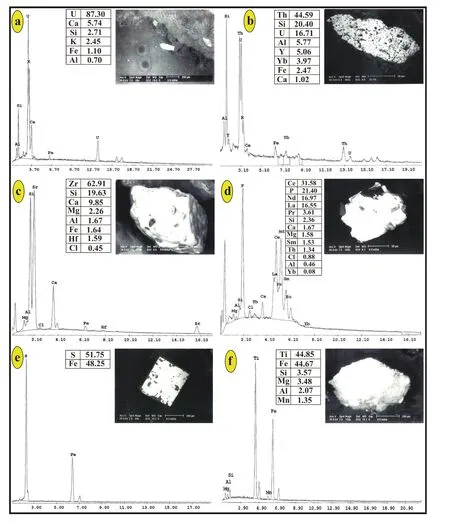
Fig.4 EDX and BSE image showing a Uranophane,b Uranothorite,c Zircon,d Monazite,e Pyrite and f Ilmenite minerals,the felsic volcanic rocks,Eastern Desert,Egypt of the Arabian-Nubian Shield
4.3 Whole-rock geochemistry
Eighteen(18)samples of the felsic volcanic rocks of the Arabian-Nubian Shield were selected for the whole-rock major,trace,and rare earth element analyses.The data are listed in’’Online Resource 1′’.Geochemistry of major,trace,and rare earth elements of felsic volcanic rocks are described as follows.
4.3.1 Major and trace geochemistry
Concentrations of major oxide and trace element contents are compared with other volcanic rocks(e.g.late Jurassic Stretsovkoye caldera in Transbaikalia,Russia(Chabiron et al.2003).The studied felsic volcanic rocks possess high contents of SiO2(av.73.92 wt%),Na2O(av.3.66 wt%),and K2O(av.3.93 wt%)as these rocks belong to the rhyolite series.The other oxides are relatively low as,TiO2(av.0.32 wt%),MnO(av.0.05 wt%),P2O5(av.0.06 wt%),MgO(av.0.73 wt%)and CaO(av.0.59 wt%),indicating their high degree of fractionation(Online Resource 1).Whereas the volcanic rocks of Stretsovkoye caldera show SiO2(73 wt%-79 wt%)and low FeO,CaO,MgO,and TiO2contents.The studied felsic volcanic rocks show higher content of trace elements(Zr,Nb,Ba,Rb,U,and Th;Online Resource 1).Whilst the volcanic rocks of Stretsovkoye caldera show Zr (245-261 ppm),Rb(289-475 ppm),Nb(52-62 ppm),Th(62-79 ppm),and U(7-28 ppm)(Chabiron et al.2003).
Felsic volcanic rock samples from the W.El Miyah and W.Shait of the Arabian-Nubian Shield are assorted into calc-alkaline rhyolite and tholeiitic rhyolites.The calc-alkaline rhyolite f lows from the W.El Miyah have moderate levels of Zr/TiO2(656-855)and Nb/Y(0.7-0.9)(Online Resource 1).The calc-alkaline rhyolite samples have moderate Zr/Nb and Zr/Y(7.7-18.5)values like to issued values for calc-alkalic rocks(Leat et al.1986;Barret and Maclean 1999)(Fig.5a).The calc-alkaline rhyolites have moderate ratios of Zr/Sc (27.5-44.5)and Zr/TiO2(750-864)(Figs.5b and c),whilst,the tholeiitic rhyolites have higher levels of Zr/Nb (15.6-21.5), Nb/Ta(20.0-21.7),and Zr/Sc(9.5-16.4)than the calc-alkaline rocks(Fig.5a).The Ti/Sc ratios(142.38-569.53),and also the Nb/Ta ratio(3.64-9.00)for the felsic volcanic rocks(Online Resource 1),are similar to rocks generated from the continental crust(Nb/Ta 10-12 and<16;Taylor and McLennan 1995;Barth et al.2000).The Ga/Al ratio in the rhyolitesismoderate owing to their low amountsof Al2O3,when plotted on the Ga/Al versus Zr diagram,the studied samplesof thefelsic volcanic rocksplot on theboundary of the I/S-to A-type f ield with moderate to low Zr levels(Fig.5d).
In felsic volcanic rocks of the different studied areas of the Arabian-Nubian Shield,Aluminum and Scandium are extremely depleted but notably,the amounts of Vanadium are elevated compared to Scandium that supposes possible magnetite accumulation.The potentiality of Ti-rich stage crystallization is supported in part by the broadly inverse relationship of the size of the negative anomaly of Nb(primitive mantle-normalized Th/Nb)to TiO2and Sc(Fig.5e and f).The directory for a history of crustal melting also supposes that the negative Nb signature could be created from its crustal source as the upper continental crust has a negative anomaly of Nb on primitive mantlenormalized plots(Sun and McDonough 1989).
In the primitive mantle-normalized trace element diagram(Fig.5g),all the investigated samples reveal enrichment in high f ield strength elements(HFSE,e.g.Zr,Ta,Nd,Th,and U)and in large-ion lithophile elements(LILE,e.g.Pb and Rb),due to the presence of radioactive minerals as,uranophane and uranothoriteand depletion in Nb,Sr,P,and Ti.This depletion may arise from the remelting or arc crust(Whalen et al.1998)and/or from the fraction of high f ield strength elements and Ti-enriched stages(Green and Pearson 1987;Ryerson and Watson 1987;Lentz 1999).
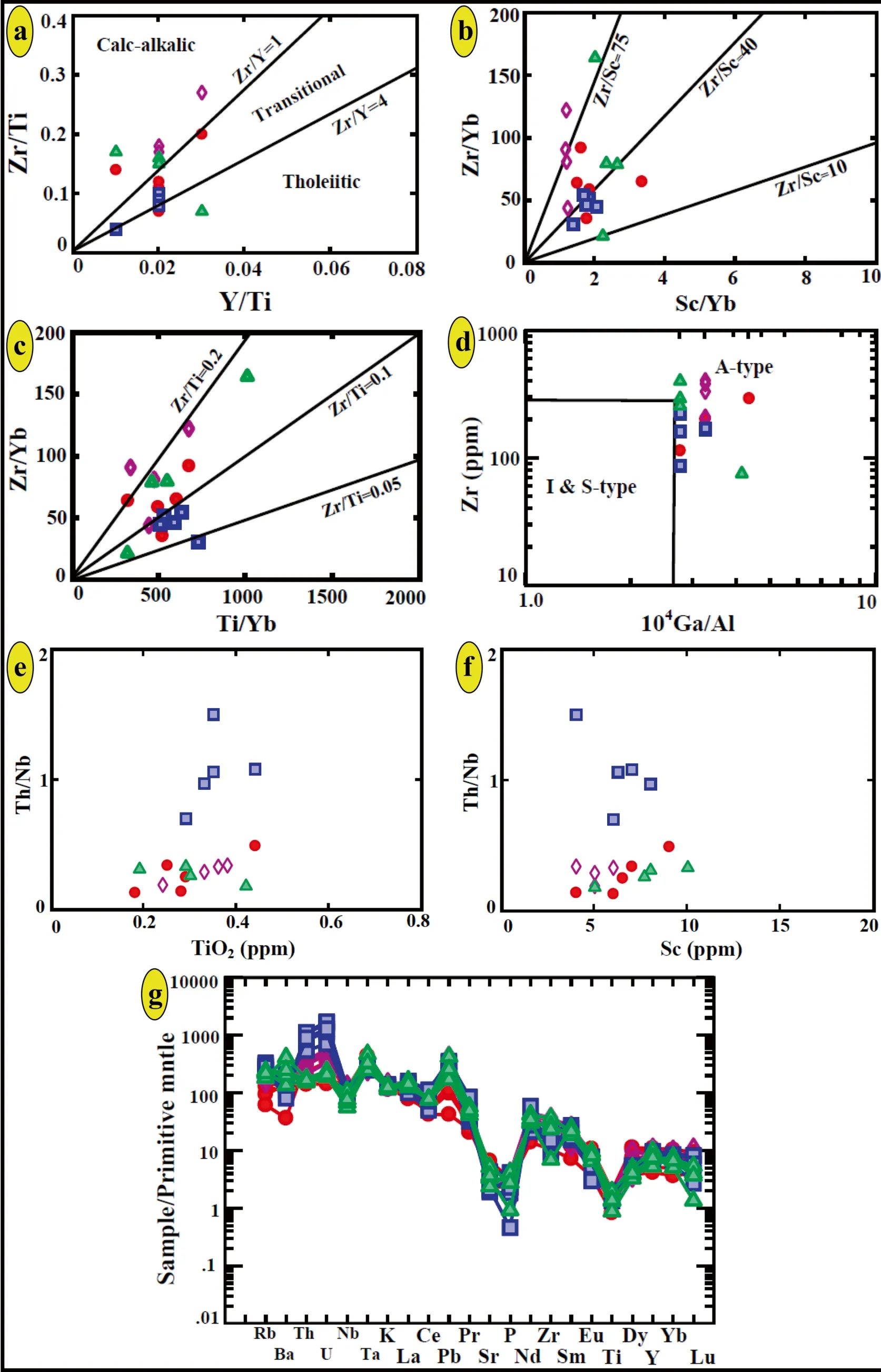
Fig.5 a Zr/Ti-Y/Ti plot for deciphering the tholeiitic versus calcalkaline aff inities of the rhyolites from Lentz(1998,1999),b Zr/Yb-Sc/Yb,c Zr/Yb-Ti/Yb,d Ga/Al-Zr plot of Whalen et al.(1987),e Th/Nb pm vs.TiO2,f Th/Nb pm vs.Sc and g Primitivemantle-normalized plots for the felsic rocks,primitive mantle values from Sun and McDonough(1989).Symbols are the same for all next grams Felsites at W.Ranga,Felsitesat W.Shait,Felsitesat W.El Miyah and Felsites at G.Atalla of the Arabian-Nubian Shield
4.3.2 REE elements geochemistry
The felsic volcanic rocks of the Arabian-Nubian Shield display great enrichment in light rare earth elements(LREEs)(177.4-423.9 ppm)relative to heavy rare earth elements(HREEs)(10.8-30.6 ppm)with(La/Yb)Nof 13.53-37.93,(Online Resource 1).The depletion of heavy rare earth elements compared to light rare earth elements indicates that garnet was residual in the source.Where compared with the volcanic rocks of Stretsovkoye caldera(Chabiron et al.2003),the studied felsic volcanic rocks show higher contents in La,Ce,and Nd(Online Resource 1).The volcanic rocks of Stretsovkoye caldera showed higher contents of rare earth elements: i.e., La(49-57 ppm),Ce(74-103 ppm),and Nd(21-26 ppm)(Chabiron et al.2003).Normalized REEs patterns relative to chondritic values of Boynton(1984)(Fig.6a-d)show signif icant high negative oddity of Eu (Eu/Eu*=0.15-0.81)and negative Ce/Ce*oddities(0.83-1.30)(Online Resource 1).The high depletion of Eu is coordinated with signif icant crystallization of plagioclase(Niu and O’Hara 2009),during the evolution of magma from their respective parental melts although the varying extent of crustal melting with plagioclasefound asaresidual stage may also award comparablemodels.Thenegativeanomaly of Eu may also ref lect higher oxidation conditions in the evolved melts(McKay 1989).

Fig.6 Chondrite normalized REEpatterns for felsic volcanic rocks at a W.Shait,b W.Ranga,c W.El Miyah and d G.Atalla in the Eastern Desert,Egypt of the Arabian-Nubian Shield.Normalizing factors are from Boynton(1984)
When plotted on the Ta/Yb versus Th/Yb diagram of(Pearce 1982,1983)(Fig.7a),the samples have the signature of an enriched intraplate mantle source inf luenced by a crustal contamination process with Th which ishigher inf luence than Ta and Yb during the processes of crustal contamination.Consequently,rocks with crustal contamination reveal high levelsof Th/Yb(Wilson 1989)and act at an active continental margin.When plotted Ce/Yb versus Ce diagram showsthat the samples can be derived through partial melting trend while an additional crystal fractionation(Fig.7b).When plotted over Th,Yb,and Zr variations versus Eu/Eu*diagrams,(Fig.7c-e)shows that the minor magnitude of negative Eu oddities of W.Ranga and G.Atalla felsites to pronounced and higher magnitude of negative Eu oddities for W.Shait and W.El Miyah felsites(Hollings and Kerrich 2000).Rhyolites of the different studied areasshould probably be associated with the rifting of the continental crust,which is also identified by steep REEslopeshowing theinvolvement of crustal material to a larger extent.
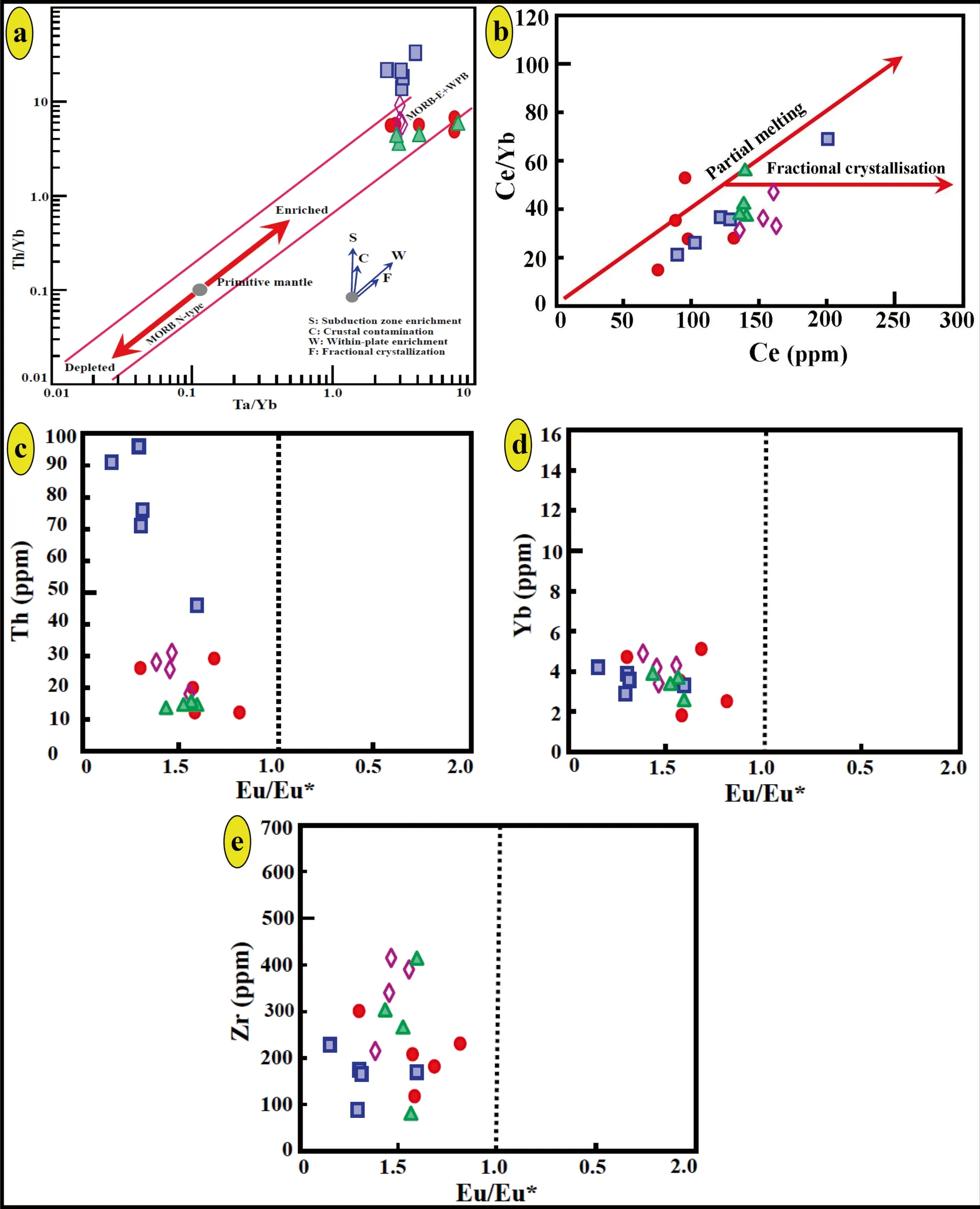
Fig.7 Th vs.Eu/Eu*,d Yb vs.Eu/Eu*and e Zr vs.Eu/Eu*for the felsic volcanic rocks in the Eastern Desert,Egypt of the Arabian-Nubian Shield
4.3.3 REE tetrad effect
The lanthanide tetrad effect indicates that the characteristics of lanthanide compounds are not a smooth function of atomic number(Masuda et al.1987).In geochemistry the term of tetrad effect refersto that thef ifteen(15)lanthanide elements are divided into four main types in a chondritenormalized distribution pattern:1,La-Ce-Pr-Nd,2,Pm-Sm-Eu-Gd,3,Gd-Tb-Dy-Ho and 4,Er-Tm-Yb-Lu,and each group forms a smooth convex(M-type)or concave(W-type)model(Masuda et al.1987).Particularly,for the granitic rocks which have undergone a high degree of fractional crystallization,hydrothermal alteration,and mineralization,the tetrad effect was progressively realized(Zhao et al.1993;Lee et al.1994;Bau 1996;Irber 1999).The worth of tetrad effect of felsic volcanic rocks was ranked according to the quantif ication method of Irber(1999)owing to the simplicity of the calculation and also of the convenience of the composition with the calculated data of Irber(1999):-

REE tetrad effect was essentially noticed in late magmatic differentiation associated with strong hydrothermal interactions or deuteric alteration(Masuda et al.1987;Monecke et al.2002).For an REE pattern without tetrad effect are samples with values of TE1.3<1.1,where at TE1.3>1.1 the tetrad effect becomes well visible.U,Zr/Hf,Nb/Zr,Rb/Sr,Eu/Eu*,Nb/Ta variationsto TE1,3values diagrams(Fig.8)show that the minor magnitude of negative Zr/Hf,Nb/Zr of felsites to pronounced and a higher magnitude of positive U,Rb/Sr,Eu/Eu*,Nb/Ta of the felsites.The investigated felsic volcanic rock samples reveal the M-typetetrad effect(Fig.6),wherethevaluesof TE1.3are greater than 1.1(Online Resource 1).

Fig.8 Plots of U,Zr/Hf,Nb/Zr,Rb/Sr,Eu/Eu*,Nb/Ta variations for TE1,3 values diagrams,the felsic volcanic rocks in the Eastern Desert,Egypt of the Arabian-Nubian Shield
4.4 Radioactivity
4.4.1 Distribution of uranium and thorium in the studied rock types
Field spectrometric measurements are performed along with the four investigated areas of felsite of the Arabian-Nubian Shield by using a portable four-channel(dose rate(D.R.),K,eU,and eTh),well-calibrated and high-sensitivity model RS-230 spectrometer.Statistically,the resulted spectrometric data were calibrated to indicate the distribution properties of radioelements and their ratios in the different studied areas of felsites(Table 1).The eU value ranges from 0.50 to 86.10 ppm(av.17.50 ppm),eTh from 2.90 to 181.90 ppm(av.47.03 ppm),eU/eTh from 0.1 to 0.90(av.0.37),and eTh/eU from 1.11 to 10.47 of(av.2.99),all in felsite of W.Ranga.The eU value of felsite at W.Shait ranges from 2.30 to 99.10 ppm,(av.15.93 ppm); eTh from 1.00 to 415.10 ppm (av.40.50 ppm);eU/eTh from 0.05 to 1.95(av.0.41)and eTh/eU from 1.00 to 21.96(av.3.03).Felsites of W.El Miyah are distinguished by strong radioactivity,which ranges from 1.00 to 93.40 ppm with an average(av.32.58 ppm)for eU and from 5.90 to 265.70 ppm with an average of 89.04 ppm for eTh.Felsites of W.Atalla possess the greatest radioactivity among all studied different areas.They contain a wide range of radioactivity constituents 2.00 to 121.0 ppm(av.27.64 ppm)for eU and from 4.30 to 242.00 ppm(av.65.59 ppm)for eTh.Furthermore,they display various ratios ranging from 0.14 to 4.22 with an average of 0.48 for eU/eTh and 0.24 to 7.16 with an averageof 2.77 for eTh/eU.Thehighest contentsof eU and eTh can be assigned to Th-mineralization and the existence of accessory minerals bearing radioactive materials such as uranophane,uranothorite,monazite,and zircon.
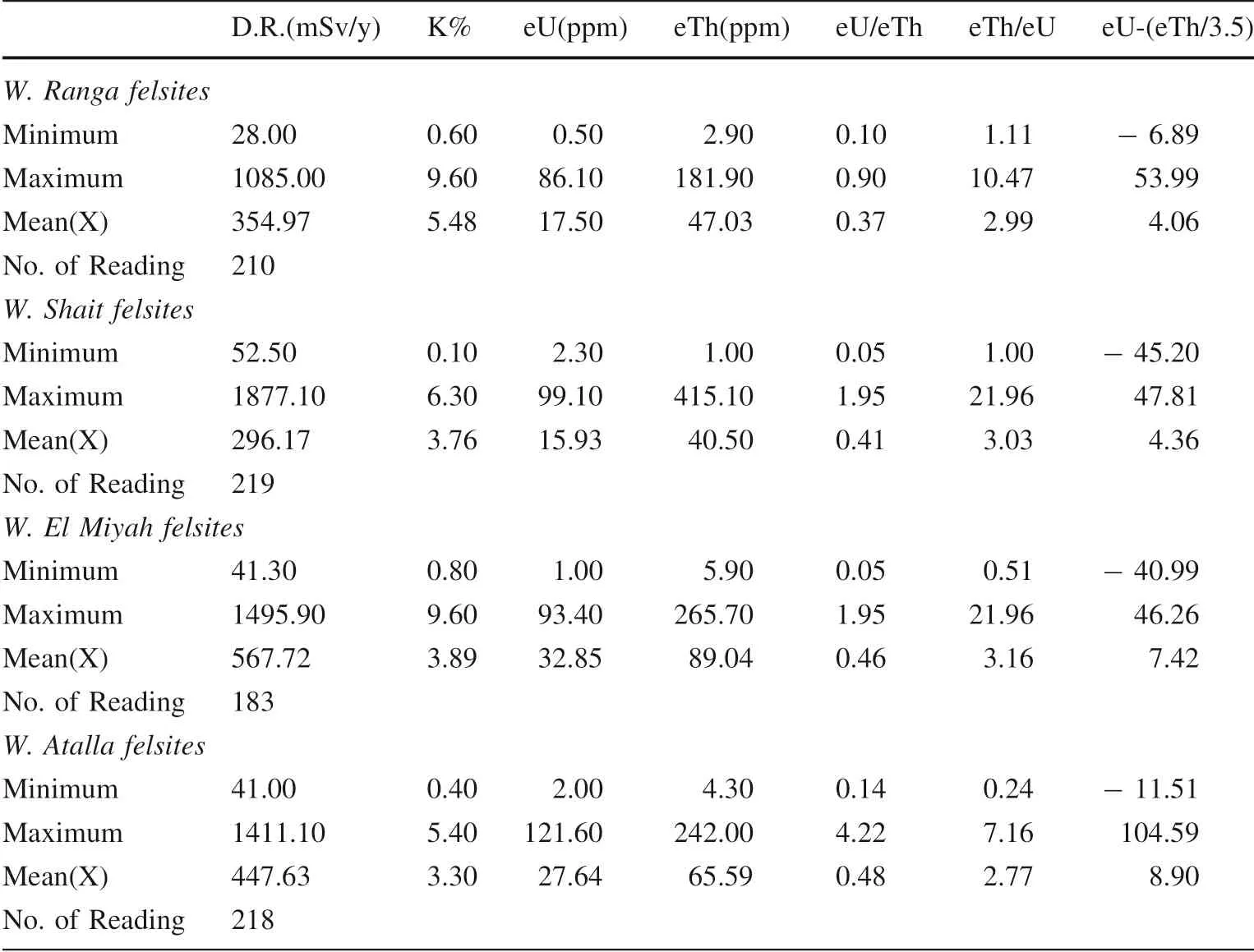
Table 1 Summary of the statistics for the surface distribution of the three radioelements K(%),eU(ppm),eTh(ppm),and their ratios for the felsic volcanic rocks of different studied areas,Eastern Desert,Egypt of the Arabian-Nubian Shield
5 Discussion
5.1 Geochemical classif ication,tectonic implications,and the potential source of the magmatism
The total alkalis-silica(TAS)(Na2O+K2O)versus silica(SiO2)geochemical classif ication diagram constructed by Le Baset al.(1986)indicates that all thestudied samplesof felsic volcanic rocksplot in the f ield of rhyolite(SiO2≈70 wt%-76 wt%)of the sub-alkaline magma series in the sense of Miyashiro(1978),but they possess a signif icant scatter due to alkali mobility(Fig.9a).On the diagram of Maniar and Piccoli(1989)Al/(Na+K)versus Al/(Ca+Na+K),dataof thestudied felsic volcanic samplesplot in thef ield of peraluminous(Fig.9b).The AFM(FeO*versus MgO and Na2O+K2O)diagram of Irvine and Baragar(1971)shows that,the majority of samples plot in the f ield of calc-alkaline with someexceptionsplot on theboundary between tholeiitic and calc-alkaline f ields(Fig.9c).The diagram of Whalen et al.(1987)(FeOt/MgO)versus(Zr+Nb+Ce+Y)shows that all the studied felsic volcanic samples are more specif ically crustally derived from A-type granite(Fig.9d).The variations of SiO2versus K2O diagram constructed by Rickwood(1989)reveals that all the studied felsic volcanic samples belong to a typical high-K and calc-alkaline series(Fig.9e).

Fig.9 a Total alkalisversussilicaplotsof Le Baset al.(1986),b The Shand’s index of Maniar and Picoli(1989),c AFM plot(Irvine and Baragr 1971),d Plots of FeOt/MgO vs.Zr+Nb+Ce+Y,The f ields of I-,S-and A-type granites are from Whalen et al.(1987),e SiO2-K2O diagram after(Rickwood 1989),f The studied the felsic volcanic rocks plotted on f ields of hydrothermal and g diagenetic alterations in the alteration box after(Large et al.2001).The arrows show the common trends for hydrothermal alteration,the felsic volcanic rocks in the Eastern Desert,Egypt of the Arabian-Nubian Shield
The alteration diagram was created with two alteration indices f irstly,the Hashimoto alteration index(Ishikawa et al.1976)to account for feldspar and glass breakdown to sericite and chlorite,and secondly,a chlorite-carbonatepyrite index.The diagram also supplies a box for felsic rocks that are typically unaltered and f ields for diagenetic and hydrothermal alteration reactions.According to Large et al.(2001),the alteration box plot is a graphical representation that uses two alteration indices:the Ishikawa alteration index (AI)=100(K2O+MgO)/(K2-O+MgO+Na2O+CaO),and the chlorite carbonate pyrite index (CCPI)=100(MgO+FeO)/(MgO+FeO+Na2O+K2O)(Fig.9f and g).Accordingly,the studied felsic volcanic rock samples plot in an alteration box in the diagenetic alteration f ield(Fig.9g).
The plotting of Ta versus Yb diagram of(Pearce et al.1984)shows that all the studied felsic volcanic samples plot in the f ield of within plate granite(WPG)(Fig.10a)and with A-type aff inities(Fig.10b).The diagram Th/Ta versus Yb constructed by Gorton and Schandl(2000),which is used to distinguish between the tectonic settings for arc-related and within-plate felsic to intermediate volcanic rocks(Fig.10c)reveals that all the studied felsic volcanic samples plot in the f ield of within plate volcanic zone except two samples from W.El Miyah felsite plot in an active continental margins f ield.
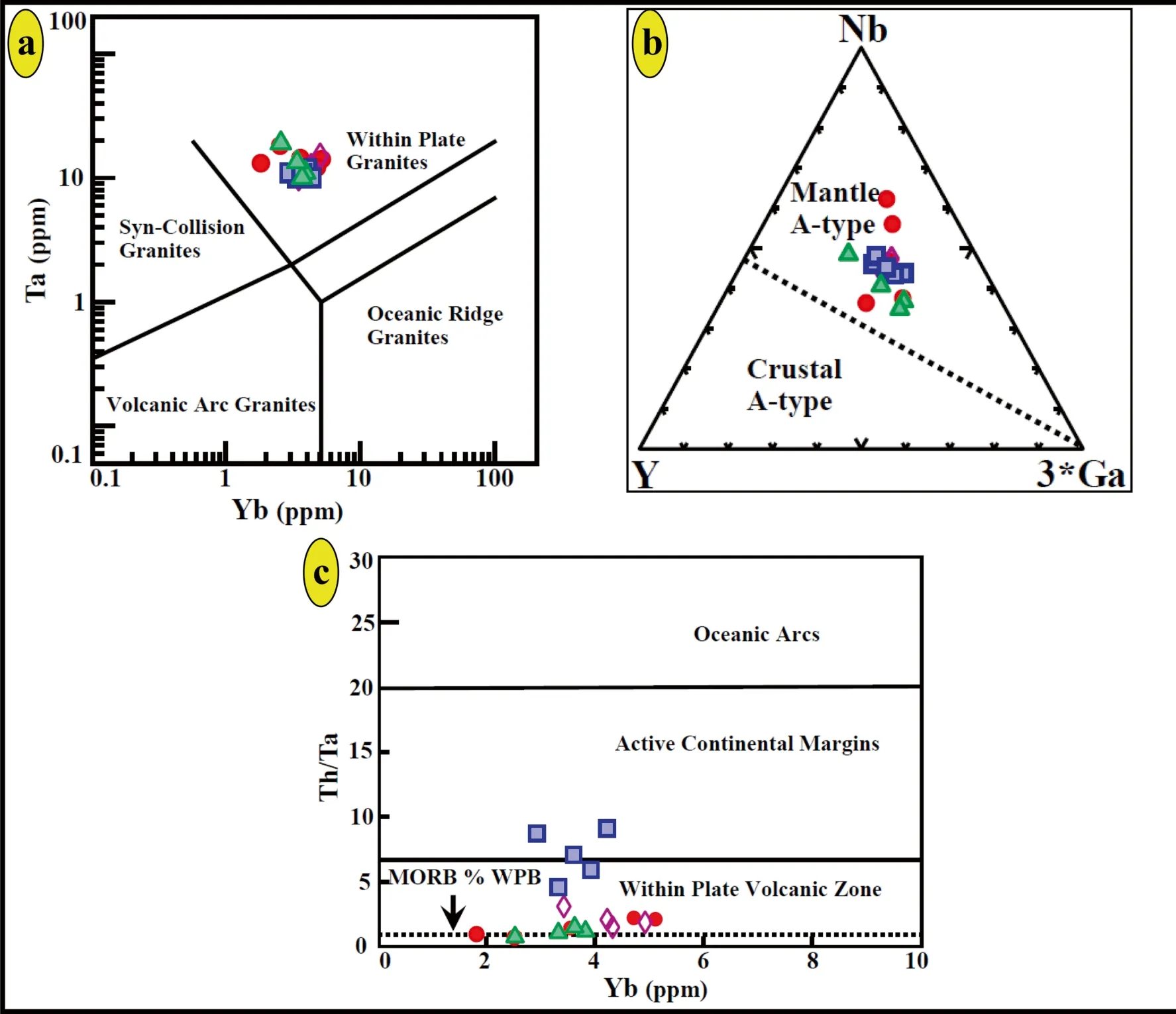
Fig.10 a Ta vs.Yb tectonic discrimination diagram after(Pearce et al.1984),b Nb-Y-3*Ga plots of Eby(1992),and c Yb-Th/Ta tectonic setting diagram after(Gorton and Schandl 2000),the felsic volcanic rocks in the Eastern Desert,Egypt of the Arabian-Nubian Shield
5.2 Petrogenesis
Sundry diagrams for the petrogenesis of the felsic volcanic rocks have been suggested,implicating:1,fractional crystallization of an original maf ic-intermediate mantlederived magma(Brown et al.1984),2,crust-mantle interaction(Kerr and Fryer 1993),and 3,partial melting of a crustal source(Shellnutt et al.2011).The plotting of Nb versus Y and Ce ternary diagram of(Eby 1992)reveals that,all the studied samples plot in the f ield of mantle A-type(Fig.11a).The plotting of Th/Nb versus La/Nb diagram(Fig.11b)constructed by Plank(2005)reveals that the source of the felsic volcanic rocks of different studied areas is similar to that of OIB of metasomatic enrichment origin(Niu 2008;Pilet et al.2008).However,the weak arc-like or continental crust signature(Nb-Ta-Ti depletion)isconsistent with the metasomatism taking place in the mantle wedge setting(Donnelly et al.2004).
The ternary diagram K2O versus Cao and Na2O constructed by Guo et al.(2012)shows that all the studied felsic volcanic samplesplot in thef ield of medium-to high-K melts(Fig.11c)indicating that the felsic volcanic rocks were derived from medium to high-K protoliths.The plotting of SiO2versus K2O diagram(Fig.11d)constructed by Zhang et al.(2017)shows that the majority of the studied felsic volcanic samplesare like those generated from hydrous melting of basic rocks(e.g.,quartz-hornblende).Subsequently,the studied samples were derived from partial melting of a quartz-amphibolite facies maf ic crust.
The diagram SiO2versus(Na2O+K2O)constructed by Le Bas et al.(1986,1992)(Fig.11e)shows that one direction can be designed:the f irst direction is distinguished by increasing of silica and alkalis with a87Sr/86Sr at c.0.7066,i.e.a silica saturated direction causing the crystallization of felsic volcanic rock samples of the different studied area,whilst the second direction where the amount of silica decreases(silica-undersaturated direction)cannot be designed.The plotting of Al2O3/TiO2versus CaO/Na2O diagram(Fig.11f)of(Wang et al.2007)implies that some samples of felsic volcanic rock reveal a scattered pattern but most of thesamplesplot in thef ield of peraluminous granite(Sylvester 1998).Samples of Wadi Shait felsites possess lower content of CaO/Na2O than all other felsites,perhaps revealing a plagioclase poor source or more involvement of continental crust,whilst samplesof Wadi Ranga felsite and G.Atalla felsite have the highest contents of CaO/Na2O,showing plagioclase rich source(Chappell and White 1992;Sylvester 1998).W.Shait and W.El Miyah felsites with a lower Al2O3/TiO2ratio than W.Ranga and G.Atalla felsites signify the existence of garnet in the source region and was created at higher temperature and pressure than other rhyolites(Sylvester 1998)(Fig.11f).The Rb-Ba diagram(Fig.11g)and strong negative Ti,Sr,and P oddities(Fig.5g)uphold the fractionation of plagioclase and K-feldspar of felsic volcanic rocks of different studied areas.

Fig.11 a Nb-Y-Ce of Eby(1992),b La/Nb vs.Th/Nb diagram,(modified after Plank 2005).Averageocean island basalts(OIB),bulk continental crust(BCC),upper continental crust(UCC)and MORB,mid-ocean ridge basalts,c K2O-Na2O-CaO diagram after(Guo et al.2012),d SiO2 versus K2O after(Zhang et al.2017),e Selected volcanic rock compositions,recalculated on H2O-and CO2-freebasis,plotted in the total alkali-silica(TAS)diagram (Le Bas et al.1986,1992).The silica undersaturated-saturated boundary(U-S)is indicated,f Al2O3/TiO2 vs.CaO/Na2O diagram derived from Wang et al.(2007)and g Vector diagram of fractional crystallization(Rb vs Ba),the felsic volcanic rocks in the Eastern Desert,Egypt of the Arabian-Nubian Shield
5.3 Uranium and thorium radioactivity
TheeTh/eU model of the investigated felsic volcanic rocks of different areas of the Arabian-Nubian Shield(Figs.12a,13a,14a,and 15a),indicates enrichment of U where the greatest concentrations of eU and eTh are for the felsite samplesof W.Shait and W.Atalla(Figs.13a and 15a).The majority of the samples range between 2.0 and 5.0 eTh/eU ratio with both eU and eTh ratios increasing simultaneously(Figs.13a and 15a).In the original rock,U stayed relatively immobile.The radioactivity increases gradually during magmatic fractionation,according to this diagram,but the ratio differs owing to the different processes of alteration(Heikal et al.2019).
Figures(12b,13b,14b,and 15b)show the relation between eU/eTh ratio and eU which indicates a strong direct slope that shows hydrothermal U enrichment.Whilst,the eU/eTh versus eTh model(Figs.12c,13c,14c,and 15c)reveals a reverse relationship,in which eU/eTh ratio for most plotted samplesof thedifferent studied areas increases with decreasing eTh,showing the vital role of hydrothermal solutions in the redistribution of these elements.Therefore,various processes of alteration play an important role in the mobilization of U.Most samples of the studied felsic volcanic rocks of the different areas have more U concentration(Table 1)than that of the hypothetical U distribution(Figs.12d,13d,14d,and 15d)and therefore,the mobilization provides positive levels,which in turn show that the uranium of the studied rock types is migrated in(Cambon 1994).Finally,the statistical results of the radioactive measurements,which is on the binary diagramsof eTh vs.eU,eU vs.eU/eTh,and eU against eUeTh/3.5(Figs.12,13,14,and 15)indicate that the felsic volcanic rocks of the different studied area have been distinguished by high enrichment U-mineralization.
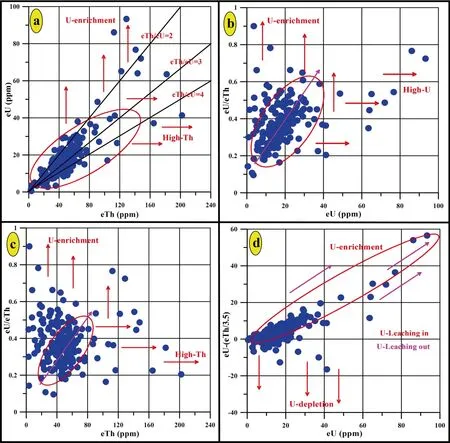
Fig.12 Radioactive elements plot for ground gamma-ray spectrometry measurementsof the felsite of W.Ranga area,Eastern Desert,Egypt of the Arabian-Nubian Shield
5.4 Origin of uranium and REE mineralization
Felsic volcanic rocksact asaprimary and secondary source of uranium and rare earth elements(REEs)mineralization(Maithani and Srinivasan 2011).Rare-earth element occurrences associated with felsic volcanic rocks are essentially derived from the fractional crystallization of REE-rich magmatic f luids(Dostal 2017).The Rare earth element mineralization isgenerated by magmatic aswell as by hydrothermal process and the latter has enriched the REE concentration in the peralkaline host rock(Dostal 2016).REEs phosphate-monazite and zircon minerals have been considered as magmatic origin as they occur as euhedral shape and small in size and appear as separate grains and inclusions within the quartz and alkali feldspar.REE phosphate,mainly monazites has been created by the interaction of REE-rich magmatic meltswith largecontents of phosphate-rich f luid in themagmachamber.Monaziteof hydrothermal type varies from the monazite of magmatic type by its concentration of thorium.The other REE accessory stages such as allanite which were derived from the magmatic process and were crystallized as the end product of the melt that was enriched by REE during fractional crystallization.The contents of REE in felsic volcanic rocks are also increased through the late-stage of f luid activity(Hogarth et al.1985).The complexes of REE f luorocarbonates(bastnaesite)and REE phosphate(monazite)were formed due to the late-stage hydrothermal activity.The REE-f luorocarbonatescrystallization could be the existence of numerous REE,F,and great contents of CO2in the magmatic f luid.The generation of REE carbonates from hydrothermal systems which are associated with carbonatiteshasbeen argued by Hogarth et al.(1985).

Fig.13 Radioactive elements plot for ground gamma-ray spectrometry measurements of the felsites of W.Shait,Eastern Desert,Egypt of the Arabian-Nubian Shield
The REE mineralization in the studied felsic volcanic rocks of the Eastern Desert,Egypt of the Arabian-Nubian Shield is chief ly created by the magmatic process and the later stage was enriched by the post-magmatic hydrothermal processes.The magmatic process and also the hydrothermal process for REE mineralization within the felsic volcanic rocks were supported by the morphological character,texture,and chemical composition of REE minerals.For many kinds of uranium deposits,felsic volcanic rocks are considered the source of uranium(Nash 2010).However,in the United States,volcanogenic deposits reach up to less than 0.5%of total production and have a reputation of very low economic importance(Nash 2010).The classif ications or patterns of volcanogenic U deposits are too limited and concentered on features like calderas,for purposes of exploration and resource assessment.As well as,the patterns tend to be genetic and include terms like‘‘hydrothermal vein’’but this approach is not helpful in regional mineral resource assessment.The caldera was created by the eruption of mildly peralkaline rhyolite magma which was enriched by F and U(15-23 ppm)(Chabiron et al.2001).The largest uranium deposit in the world,the Olympic Dam deposit in Australia,might be considered to be volcanogenic in a structural setting(Nash 2010).
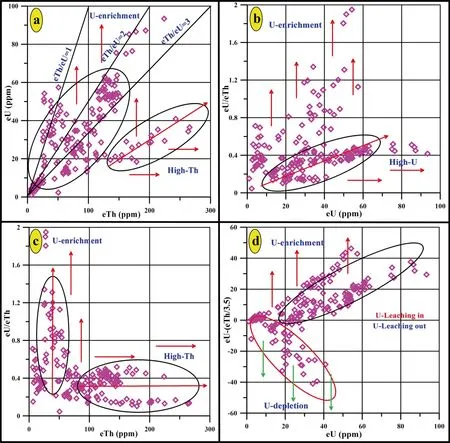
Fig.14 Radioactiveelementsplot for ground gamma-ray spectrometry measurementsof thefelsitesof W.El Miyah area,Eastern Desert,Egypt of the Arabian-Nubian Shield
George et al.(1991)stated that the mobilization and mi gration of uranium proceeded during three or more phasesdistinguished by discrete temperaturesand chemical processes,through detailed mineralogical and geochemical studies.Firstly,uranium was mobilized and deposited in felsic volcanic rocks as f ine coatings at high-temperature phases.During devitrif ication,the high-temperature phase was possibly deposited by a magmatic vapor stage.Secondly,the hydrothermal solutions distributed within fractures in felsic volcanic rocks(rhyolite),creating hightemperature kaolinite in composition,like a breccia pipe at areas.This phase was oxidized and cooled from 250 to 150°C and f luids had 0.0 to 4.9 wt%NaCl equivalent salinity.Uraninite and pyrite were deposited by mixing with a f luid that was enriched by H2S.Thirdly,this phase was distinguished by a lower temperature hydrothermal event(100-150°C)that led to the oxidation and montmorillonite alteration.

Fig.15 Radioactiveelementsplot for ground gamma-ray spectrometry measurements of the felsites of G.Atalla area,Eastern Desert,Egypt of the Arabian-Nubian Shield
Thebehavior of uranium in thefelsic volcanic rockswas extensively discussed and existed to be greater in contents(36 or more ppm of U and 12-96 ppm of Th)but slightly less leachable than the uranium in altered felsic volcanic rocks of the vapor-phase(Leroy and George-Aniel 1992).The new exploration data supposes that these areas are already favorable to uranium mineralization and the main task now isto discover higher levelsof mineralization.The secondary minerals are uranophane,and yellow uranium minerals present in halos with brown limonite.The U was deposited from hydrothermal f luids related to felsic volcanic rock intrusions according to the alteration phases,geochemical enrichments,and geologic assemblages(Castor and Berry 1981;Castor and Henry 2000).In silicic magmas,there is ample evidence for the enrichment of uranium,but in magmatic-hydrothermal f luids,there is evidence for the enrichment of uranium.Two factorscould be optimized to 1,the volatile amount of very shallow magmas and 2,the uranium behavior in evolving magmas.Compared with other igneous rocks,the water amount of shallow rhyoliteintrusionsand extrusionsisextremely low,as ref lected in the low amount of hydrous phases such as biotite and the high viscosity of these magmas(Best and Christiansen 2001).
The f ield and geochemical evidence appeared that uranium staysin the melt relative to exsolved magmatic f luids(Nash 2010).This behavior is essentially different from minerals like Nb and Cu which escape in volatile-rich f luids which possess the ability to create ore deposits like the porphyry type.The experiments illustrated that the majorities of uranium remain in the melt stage,even under abnormally great concentrations of volatile(Keppler and Wylie 1991).The petrographic studies documented that the uranium remains in the accessory stages or in glass in U-rich magmatic rocks and is not settled in post-crystallization hydrothermal veinlets.The extensive experimental and petrographic evidence for the concentration and releasing of base minerals(pyrite)related to chloride-rich magmatic f luids(Seedorff et al.2005)does not relate to U.Uranium with its high charge and multiple oxidation states do not behave like most metals in magmatic-hydrothermal processes.Thus,someconceptsfrom seemingly similar ore systems can be misleading.Multiple stages of enrichment and transport,sometimes over millions of years,are required to move U from volcanic magmas to ore zones.Geologic processes other than those that form magmatichydrothermal metal deposits seem to be required to form signif icant U deposits(Nash 2010).
5.5 Felsic volcanic rocks(Rhyolite)magmatism
Both uranium and felsic magmasmust arisefrom thecrust,a conclusion based on heat f low and petrochemical studies(Nash 2010).Enhancements in the isotopic and geochemical analysis have awarded scientists to identify the timespace-depth relations of felsic(rhyolitic)magmas and place them in a tectonic structure(John 2001);these enhancements are related to uranium deposits as well as epithermal ore deposits(Fig.16).The extension enabled maf ic(basaltic)magma to ascent rapidly out of the crust to create the f lows and shield volcanoes.Even so,in regions the basalt underplated the crust,dissolving it and forming felsic(rhyolitic)magma at different depths.At mid-crustal depths,magma chambers tend to burst like ash-f low tuffs and createcalderas.Diapirsof viscous,water-poor,rhyolite magma tend to ascent as rhyolite domes to the surface as well.Rhyolitic magmaswereenriched with uranium aspart of the process of partial-melting.
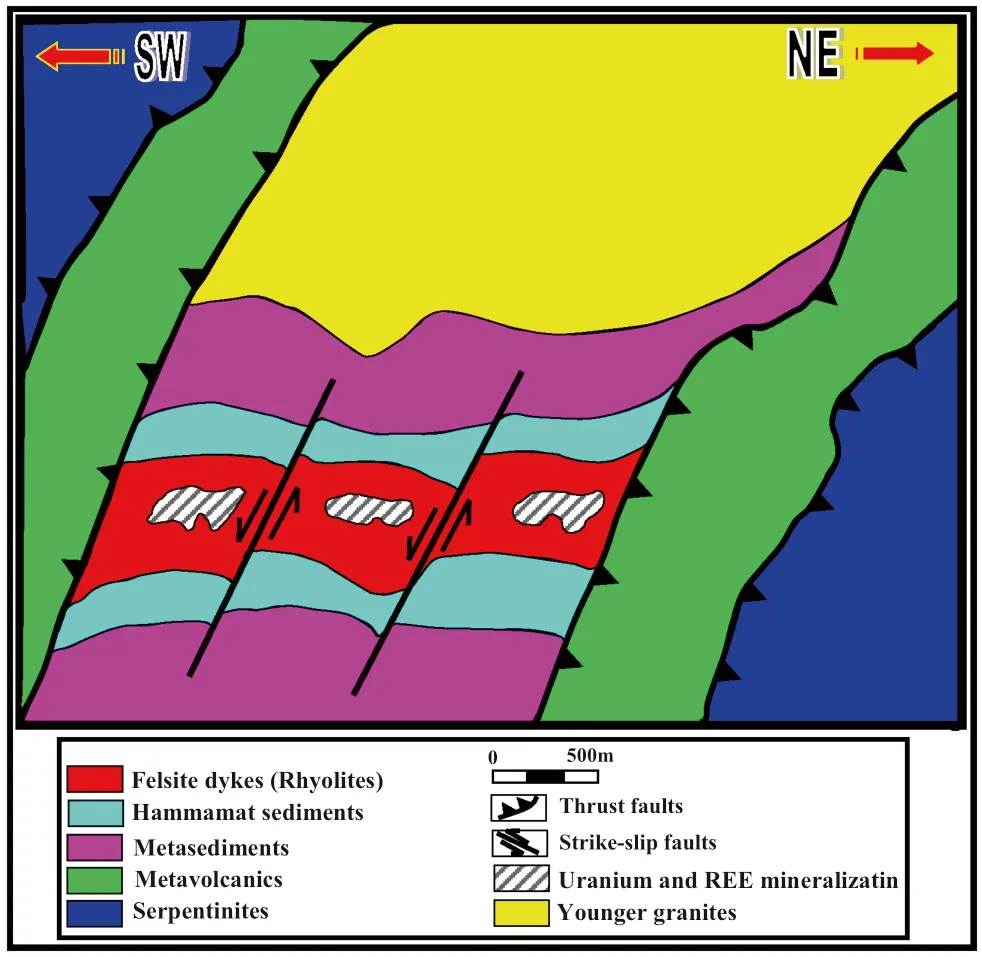
Fig.16 Cross-section showing geology and uranium mineralization of the felsic volcanics rocks,Eastern Desert,Egypt of the Arabian-Nubian Shield
Felsic volcanic rock compositions are fully recognized from the point of view of zoned magma chambers(Rytuba and Conrad 1981).Theupper part of magma chamberswas enriched by silica(rhyolite)and incompatible trace elements like Zr,Ba,Rb,Sr,Th,and U.Then,the eruption from the upper part of the magma chamber creates tuffs that were enriched by Th and U.Chemically,under oxidizing conditions,uranium is known to be mobile in which U+6types are constant and this tends to cause the wellknown separation of uranium from thorium(Hostetler and Garrels1962).Many of the felsic volcanic rocks(rhyolite),particularly alkaline or peralkaline species,related to uranium deposits contain high concentrations of thorium(30 to 80 ppm).However,the deposits of uranium themselves mostly indicate Th enrichment,and these large Th amounts are restricted to rocks that possess great concentrations of f luorine(Romberger 1999;Gibson and Wood 1997;Moine and others 1997;Nash 2010).Computations and experimental results aff irm that F complexes are the only way to transfer signif icant contents of thorium in hydrothermal solutions(Cuney and Kyser 2008).Therefore,we are left with a clear inconsistency regarding the use of thorium in the exploration and evaluation of uranium.High concentrations of Th(12-96 ppm)can be a useful standard as this possibly ref lects magmatic differentiation and potentially high concentrations of U(regardless of the probability of losing U in weathering).
6 Conclusions
The studied felsic volcanic rocks of the Arabian-Nubian Shield comprise a primary source of U mineralization to form an economic deposit.They are belonging to the rhyolite series and are peraluminous,high-K,calc-alkalic to tholeiitic aff inities and within plate(A-type)signatures.They are enriched in high f ield strength elements(HFSE,e.g.Zr,Ta,Nd,Th,and U)and large-ion lithophile elements(LILE,e.g.Pb and Rb),owing to the presence of radioactive minerals as uranophane and uranothorite and depleted in Sr,Nb,Ti,and P,this depletion can emerge from the remelting or arc crust and/or from the fraction of high f ield strength elements and Ti-enriched phases.As well,these rocks reveal strong enrichment in LREEs(177.4-423.9 ppm)relative to HREEs(10.8-30.6 ppm),which was largely transmitted from the parent rhyolite REE pattern and characterized by the strong negative oddity of Eu(Eu/Eu*=0.15-0.81)and negative oddity of Ce(Ce/Ce*0.83-1.30).The depletion of heavy rare earth elements(HREEs)relative to light rare earth elements(LREEs)reveals that the garnet was residual in the source.
The geochemical signature of the studied felsic volcanic rocks of the Arabian-Nubian Shield indicates that they were generated through aconjunction of two-phase melting process,f irstly,by the partial melting of mantle wedge infused by melting of the slab and the dehydrating f luid f low of the slab and secondly,by intra-crustal melting of the thickened continental crust caused by ascension of wedge-derived meltsand interactionsof crust-mantle.Field relations,geological package,and geochemical properties utilizing various diagrams and the properties of enriched incompatible trace elements implicating LREEs and negative anomalies of P,Nb,and Ti indicate that this bimodal volcanism of the study area symbolizes a continental arc setting.
Field spectrometric measurements and chemical analysis for uranium content in the studied felsic volcanic rocks of the Arabian-Nubian Shield showed that uranium has been enriched in these rocks.Radioactivity level reaches up to 121 ppm eU and chemical analysis of uranium content reaches up to 36 ppm in felsic volcanic rocksowing to the presence of radioactive minerals as uranophane and uranothorite.Consequently,we counseled to estimate the investigated mineralized felsite rocks by the selection of some technological samples to evaluate the preserve of radioactive minerals as well as priceless economic raremetal mineralization.
AcknowledgementsWe would like to thank Prof.Dr.M.H.Shalaby,and late prof.Dr.M.E.Ibrahim(Nuclear Materials Authority of Egypt)for their kind support,f ield facilitiesand careful reading of the manuscript.Special thanks to Prof.Dr.Ehab Korany(Nuclear Materials Authority of Egypt)for hisfruitful help in petrography.The authors are indebted to the editors of Journal of ACTA GEOCHIMICA,for reviewing and editing of the manuscript.Special thanks to anonymous reviewers for their encouraging comments and annotations that greatly improved an earlier version of the manuscript.
- Acta Geochimica的其它文章
- Correction to:Variations of methane stable isotopic values from an Alpine peatland on the eastern Qinghai-Tibetan Plateau
- Bicarbonate use and carbon dioxide concentrating mechanisms in photosynthetic organisms
- Dissolved organic carbon concentration and its seasonal variation in the Huguangyan Maar Lake of Southern China
- Geochemistry and provenance of the lower-middle pliocene cheleken formation,Iran
- Geochemistry,geochronology,and zircon Hf isotopic compositions of felsite porphyry in Xiangshan uranium oref ield and its geological implication
- Geochemistry of platinum-group elements in the podiform chromitites and associated peridotites of the Nain ophiolites,Central Iran:Implications for geotectonic setting

